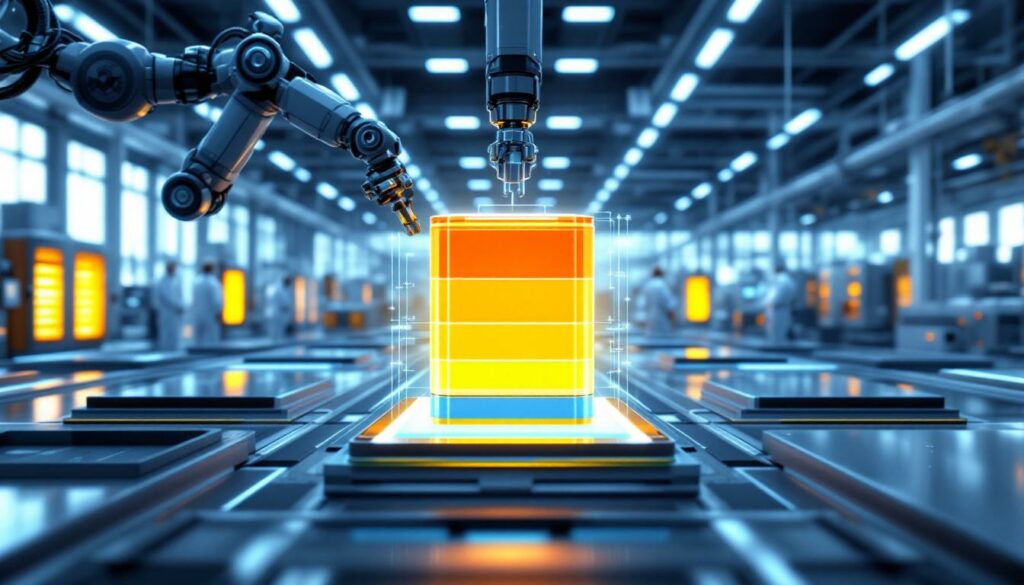The Future of Battery Manufacturing: Dürr and Grob's Revolutionary Concept Factory
The electric vehicle revolution has created unprecedented demand for lithium-ion batteries, driving manufacturers to seek more efficient production methods. The Dürr and Grob Battery Concept Factory represents a significant leap forward in addressing key manufacturing challenges, offering innovations that could reshape the industry landscape.
What is the Dürr and Grob Battery Concept Factory?
The Dürr and Grob Battery Concept Factory is a groundbreaking approach to lithium-ion battery cell production that combines cutting-edge technologies to achieve substantial improvements in efficiency and sustainability. Unveiled at Battery Show Europe in June 2025, this collaborative initiative showcases next-generation manufacturing techniques designed to overcome persistent challenges in battery production.
The concept factory represents the culmination of a partnership that began in 2022, initially including Manz as a third partner before their insolvency led to a continuation as a duo. Together, Dürr and Grob have developed a comprehensive solution that addresses the entire battery production value chain, with a particular focus on the European and North American markets.
"Dry coating represents the next generation of battery cell production, requiring 50% less space and energy compared to conventional methods," states Jochen Weyrauch, CEO of Dürr AG, highlighting the revolutionary nature of their approach.
The concept factory's innovations extend beyond mere incremental improvements, representing a fundamental rethinking of battery production processes that could significantly impact industry standards moving forward.
Key Innovations in the Concept Factory
Dry Coating Technology
Traditional battery manufacturing relies heavily on wet coating processes that consume substantial energy and require extensive infrastructure for solvent recovery. The dry coating technology developed by Dürr and Grob eliminates these requirements by:
- Removing the need for traditional drying ovens and solvent recovery systems
- Reducing energy consumption by approximately 50% compared to wet coating methods
- Using dry-mixed active materials instead of conventional solvent-based slurry
- Creating free-standing electrode films via specialized calendering machines
- Enabling complete recycling of excess film material back into production
- Implementing direct measurement of basis weight for precise coating thickness control
This approach fundamentally transforms electrode production by eliminating environmentally problematic solvents like N-Methyl-2-pyrrolidone (NMP), which has been identified as a substance of very high concern under the European REACH regulation.
Advanced Z-Folding with Integrated Notching
Battery assembly typically requires separate processes for notching electrodes and stacking them with separators. The concept factory's Z-folding innovation:
- Combines notching and folding processes in a single integrated system
- Significantly reduces the overall factory footprint
- Maintains uniform and low web tension for precise separator guidance
- Features high-quality electrode magazine technology for consistent feeding
- Achieves a remarkable 95% system availability rate
- Enhances overall production stability and reliability
"Our Z-folding technology represents years of engineering refinement to create a process that's both more space-efficient and more reliable than traditional methods," explains German Wankmiller, CEO of Grob Group. "The integrated approach eliminates transfer points between equipment, reducing potential failure points and improving overall quality."
High-Pressure Electrolyte Filling
Electrolyte filling remains one of the most critical steps in battery production, directly impacting cell performance and lifespan. The concept factory's approach:
- Operates at pressures up to 30 bar (significantly higher than previous systems)
- Substantially shortens the overall filling process time
- Enables more precise electrolyte dosing for consistent performance
- Improves cell quality through complete wetting of internal structures
- Optimizes production efficiency through reduced cycle time
The high-pressure filling system represents a significant advancement over conventional approaches, ensuring more complete electrolyte distribution throughout the cell structure while reducing production time.
How Does the Concept Factory Improve Battery Production?
Space and Energy Efficiency Benefits
The concept factory delivers substantial improvements in production economics:
- Space reduction: 50% smaller footprint compared to conventional facilities
- Energy savings: 50% less energy consumption through eliminated drying processes
- Infrastructure simplification: No requirement for large drying ovens
- Environmental impact: Removal of solvent recovery and processing systems
- Operating costs: Significantly lower utility expenses for manufacturers
These efficiency gains translate directly into reduced capital expenditure requirements for new battery manufacturing facilities and lower operating costs over the production lifecycle. For a typical gigafactory, these improvements could represent hundreds of millions in savings.
Material Efficiency Improvements
Beyond space and energy benefits, the concept factory delivers substantial material efficiency gains:
- Enhanced material utilization through recycling capabilities for electrode films
- Reduced waste throughout electrode production processes
- Minimized deformation of collector foils during processing
- Improved downstream processability for notching and stacking
- Optimized resource utilization across the production chain
The ability to recycle excess electrode material directly back into production represents a particular advantage, potentially saving millions in material costs annually for large-scale operations. This approach aligns well with recent battery recycling breakthrough technologies being developed globally.
Quality Control Enhancements
The concept factory integrates advanced quality control technologies:
- Precise measurement systems for real-time coating thickness monitoring
- Integrated quality validation throughout production processes
- Enhanced parametric control of critical manufacturing variables
- Consistent production of higher quality battery cells
- End-to-end digitalization for comprehensive quality assurance
"Quality consistency remains one of the greatest challenges in battery manufacturing," notes Weyrauch. "Our integrated approach addresses this through continuous monitoring and control of critical parameters throughout the production process."
Who Are the Partners Behind This Innovation?
Dürr and Grob Partnership Evolution
The concept factory represents the culmination of a strategic partnership:
- Collaboration initiated in 2022 to address growing battery production needs
- Originally included Manz as a third partner focused on cell assembly
- Continued as a duo partnership following Manz's exit due to insolvency
- Focused on establishing themselves as comprehensive system providers
- Combined complementary expertise in manufacturing technologies
- Developed integrated solutions covering nearly the entire battery value chain
Dürr contributes expertise in coating technology and process equipment, while Grob brings deep experience in assembly automation and precision manufacturing. Together, they offer a comprehensive solution that addresses the most challenging aspects of battery production.
Leadership Perspectives
The executive leadership of both companies emphasizes the strategic importance of their collaboration:
"This partnership demonstrates our commitment to advancing European battery manufacturing technology," states Jochen Weyrauch. "By combining our expertise, we're creating solutions that will help manufacturers meet the growing demand for batteries while improving sustainability."
German Wankmiller of Grob adds: "We can now cover almost the entire value chain for battery cell production with our own technologies. This means we can offer our customers integrated solutions from a single source, which is a significant advantage in terms of process reliability and efficiency."
Both leaders recognize the critical importance of developing manufacturing technologies that can scale rapidly to meet the accelerating demand for batteries as electric vehicle adoption increases worldwide. Their insights align with recent global lithium insights regarding supply chain development.
What Makes the Dry Coating Process Revolutionary?
Technical Advantages Over Wet Coating
The dry coating process represents a fundamental shift in electrode manufacturing:
- Complete elimination of solvents: No NMP or other environmentally problematic chemicals
- Process simplification: Fewer production steps and reduced complexity
- Environmental benefits: No VOC emissions or solvent recovery requirements
- Mechanical processing: Uses physical rather than chemical bonding mechanisms
- Gentler handling: Requires less force for lamination onto collector foils
- Improved downstream processing: Better mechanical properties for subsequent steps
"The elimination of solvents isn't just an environmental benefit—it fundamentally transforms the economics of battery production," explains a process engineer from Dürr. "We're removing entire process steps and their associated infrastructure, which translates directly to cost savings."
Production Process Comparison
The differences between traditional wet coating and the new dry approach are substantial:
| Process Stage | Traditional Wet Coating | Dürr-Grob Dry Coating |
|---|---|---|
| Material Preparation | Mix active materials with solvents and binders to create slurry | Mechanical blending of dry materials without solvents |
| Application | Apply wet slurry to collector foil | Create free-standing film via calendering |
| Drying | Pass through large drying ovens (20-30m long) | No drying required |
| Solvent Recovery | Complex systems to capture and process solvents | No recovery systems needed |
| Energy Consumption | High energy for drying and solvent recovery | Approximately 50% less energy required |
| Space Requirements | Large footprint for ovens and recovery systems | Approximately 50% less space needed |
| Material Efficiency | Limited recycling of materials | Complete recycling of excess film material |
This comparison highlights how the dry coating approach transforms multiple aspects of the production process, creating cascading benefits throughout the manufacturing chain.
How is Digital Technology Integrated in the Concept Factory?
End-to-End Digitalization Features
The concept factory incorporates comprehensive digital technologies:
- Digital twin implementation: Beginning in the planning phase and extending through operation
- Traceability systems: Tracking every component through the production process
- Quality analysis: Real-time monitoring and control of critical parameters
- Predictive maintenance: AI-driven anticipation of maintenance needs
- Data integration: Seamless communication between all production systems
- Virtual commissioning: Testing and validation in digital environment before physical implementation
This digital infrastructure creates a foundation for continuous improvement and adaptation as production requirements evolve. By capturing comprehensive data throughout the production process, manufacturers can identify optimization opportunities that might otherwise remain hidden.
Production Intelligence Benefits
The integrated digital systems deliver tangible operational benefits:
- Root cause analysis: Quickly identify sources of quality deviations
- Process optimization: Data-driven refinement of production parameters
- Quality documentation: Automated creation of compliance documentation
- Operational transparency: Clear visibility into production status and issues
- Continuous improvement: Systematic identification of enhancement opportunities
- Knowledge management: Capture and leverage institutional production expertise
"The digital integration isn't just about monitoring—it's about creating a learning system that continuously improves," notes a Dürr digital solutions specialist. "Each production run generates insights that can be applied to enhance future operations."
What Are the Market Implications of This Technology?
Cost Reduction Potential
The concept factory offers substantial economic benefits for manufacturers:
- Lower capital expenditure: Reduced space requirements mean smaller facilities
- Reduced operating costs: Energy savings translate directly to lower expenses
- Material savings: Better utilization and recycling reduce input costs
- Labor efficiency: Enhanced automation reduces staffing requirements
- Quality improvements: Less scrap and rework due to better process control
- Faster commissioning: Digital twin technology accelerates startup
For a typical gigafactory producing 20 GWh annually, these improvements could represent tens of millions in savings per year, significantly improving the economics of battery production. This is particularly relevant as new battery-grade lithium refinery projects come online globally.
Disclaimer: The financial projections provided are estimates based on available information. Actual savings will vary based on specific implementation details, regional factors, and scale of production.
Competitive Advantages for Manufacturers
Battery manufacturers implementing these technologies gain several strategic advantages:
- Accelerated production ramp-up: Faster time-to-market for new capacity
- Higher product quality: More consistent cells with better performance
- Enhanced flexibility: Adaptability to changing battery chemistries
- Sustainability leadership: Reduced environmental footprint
- Cost leadership: Lower production costs per kWh
- Space efficiency: More output from smaller manufacturing footprint
These advantages could prove particularly valuable as the battery industry continues its rapid expansion to meet electric vehicle demand, potentially separating market leaders from followers.
How Does This Concept Factory Compare to Traditional Methods?
Traditional vs. Concept Factory Comparison
The following table highlights key differences between conventional approaches and the concept factory:
| Parameter | Traditional Battery Factory | Dürr-Grob Concept Factory | Impact |
|---|---|---|---|
| Space Requirements | Baseline | 50% reduction | Smaller facilities, lower CapEx |
| Energy Consumption | Baseline | 50% reduction | Lower operating costs, reduced carbon footprint |
| Drying Process | Required | Eliminated | Simplified process flow, energy savings |
| Solvent Recovery | Required | Eliminated | Reduced environmental impact, simplified operations |
| Electrode Production | Wet coating | Dry coating option | Material efficiency, energy savings |
| Cell Assembly | Separate notching & stacking | Integrated Z-folding | Space efficiency, improved reliability |
| Electrolyte Filling | Standard pressure | High-pressure (up to 30 bar) | Faster production, improved quality |
| Material Recycling | Limited | Enhanced capabilities | Cost savings, sustainability improvements |
| Digitalization | Varies | Comprehensive end-to-end | Better quality control, continuous improvement |
This comparison demonstrates how the concept factory represents a holistic reimagining of battery production rather than simply incremental improvements to existing processes. Furthermore, these innovations complement advancements in direct lithium extraction that are improving raw material production upstream.
Key Performance Indicators
The concept factory delivers improvements across numerous performance metrics:
- System availability: 95% achieved for Z-folding system
- Energy efficiency: 50% reduction in overall energy consumption
- Space utilization: 50% smaller footprint for equivalent production
- Material efficiency: Near-complete utilization of electrode materials
- Production flexibility: Adaptability to various cell formats and chemistries
- Quality consistency: Enhanced through integrated measurement and control
- Environmental impact: Eliminated solvent emissions and reduced energy use
These performance improvements translate directly to competitive advantages for manufacturers adopting the concept factory approach.
What Future Developments Can Be Expected?
Scalability and Adaptation Potential
The concept factory technologies offer significant future potential:
- Chemistry flexibility: Adaptability to next-generation battery materials
- Format versatility: Capability to produce various cell designs (pouch, prismatic, cylindrical)
- Capacity scaling: Modular approach enables various production volumes
- Process refinement: Ongoing optimization of dry coating and Z-folding
- Solid-state compatibility: Potential adaptation for solid-state battery production
- Regional customization: Adaptability to different market requirements
This flexibility positions the concept factory approach as a future-proof investment that can evolve alongside battery technology itself. Additionally, it can be adapted to work with materials from new sources, including Australia's first underground lithium mine which is set to begin production.
Industry Adoption Outlook
Several factors will influence industry adoption of these innovations:
- Investment cycles: Implementation likely to align with new capacity additions
- Regional variations: Faster adoption in regions with higher energy costs
- Market pressures: Accelerated adoption as competition intensifies
- Policy influences: Environmental regulations may drive faster implementation
- Technology demonstration: Success of early adopters will influence others
- Cost trajectory: Declining implementation costs as technology matures
"We expect to see staged adoption as manufacturers gain confidence in these new approaches," notes Wankmiller. "The economic and environmental benefits are compelling, but the industry is naturally cautious about major process changes given the scale of investment involved."
Frequently Asked Questions About the Dürr and Grob Battery Concept Factory
What is the primary advantage of the dry coating technology?
Dry coating eliminates energy-intensive drying processes and solvent recovery systems, reducing energy consumption by approximately 50% while improving material efficiency. The technology creates free-standing electrode films without solvents, allowing excess material to be recycled directly back into production and eliminating environmentally problematic chemicals like NMP.
How much space can be saved with the concept factory approach?
The Dürr and Grob concept factory achieves approximately 50% space reduction compared to conventional battery production facilities. This dramatic improvement comes primarily through the elimination of large drying ovens and solvent recovery systems, as well as the integration of previously separate manufacturing processes like notching and stacking through the advanced Z-folding system.
What is Z-folding technology and why is it significant?
Z-folding with integrated notching combines multiple production steps (notching, stacking, and separator handling) into a single integrated system. This approach reduces space requirements while maintaining high precision in cell assembly. The system achieves 95% availability and features uniform web tension control for the separator, resulting in more stable and reliable cell production with fewer transfer points between equipment.
How does the high-pressure electrolyte filling improve battery production?
Operating at pressures up to 30 bar, the advanced filling system shortens processing time while enabling more precise electrolyte dosing. Higher pressure ensures complete wetting of internal cell structures, which contributes to higher cell quality, consistency, and potentially improved performance and lifespan. The efficiency gains also contribute to overall manufacturing throughput improvements.
Are traditional wet coating processes still available from Dürr and Grob?
Yes, the partnership continues to offer optim
Ready to Catch the Next Major Mineral Discovery?
Don't miss out on significant ASX mineral announcements that could lead to substantial returns. Discover why major mineral discoveries can transform your investment portfolio by exploring Discovery Alert's dedicated discoveries page, where the proprietary Discovery IQ model delivers real-time insights on high-potential opportunities.




